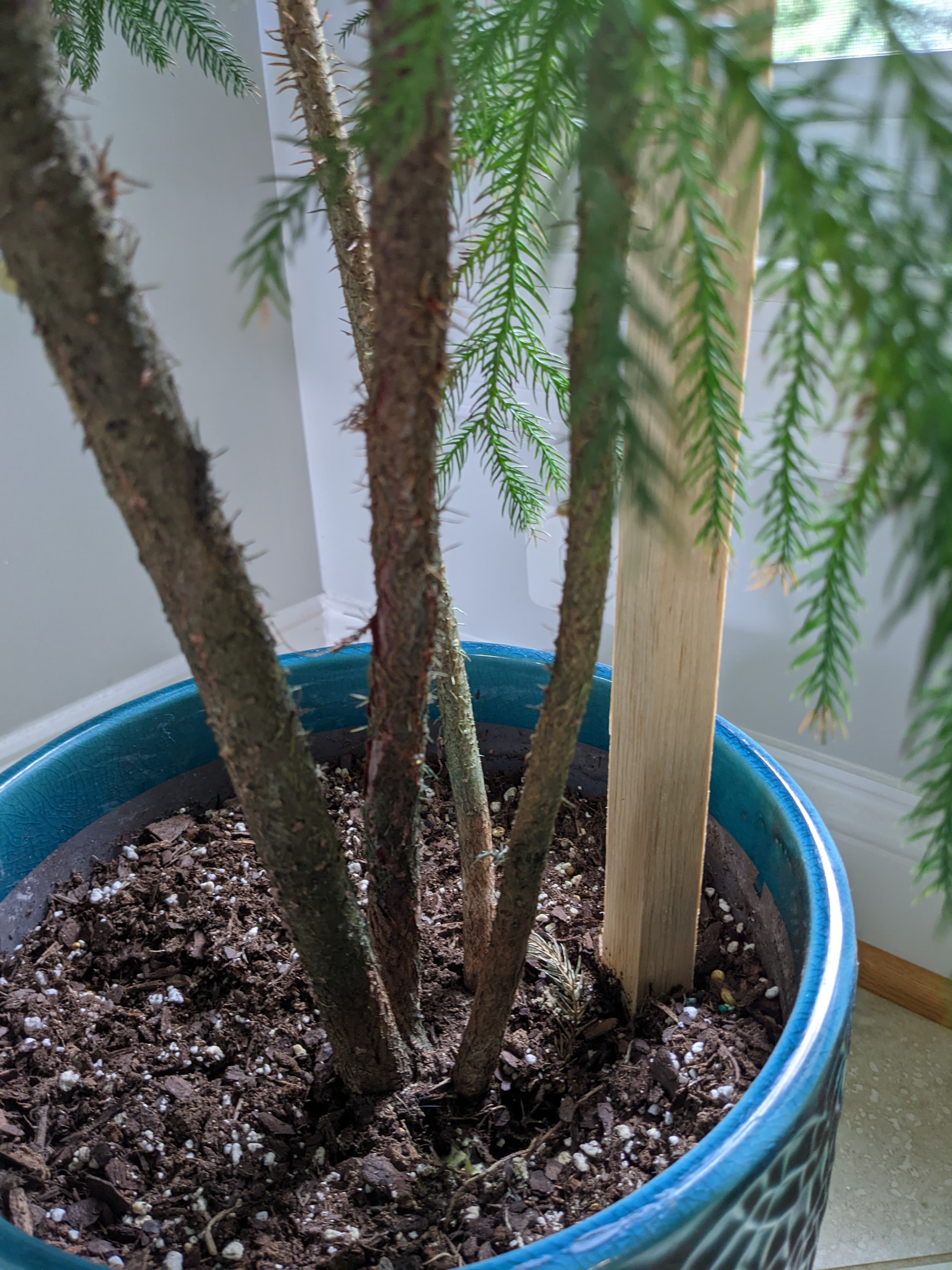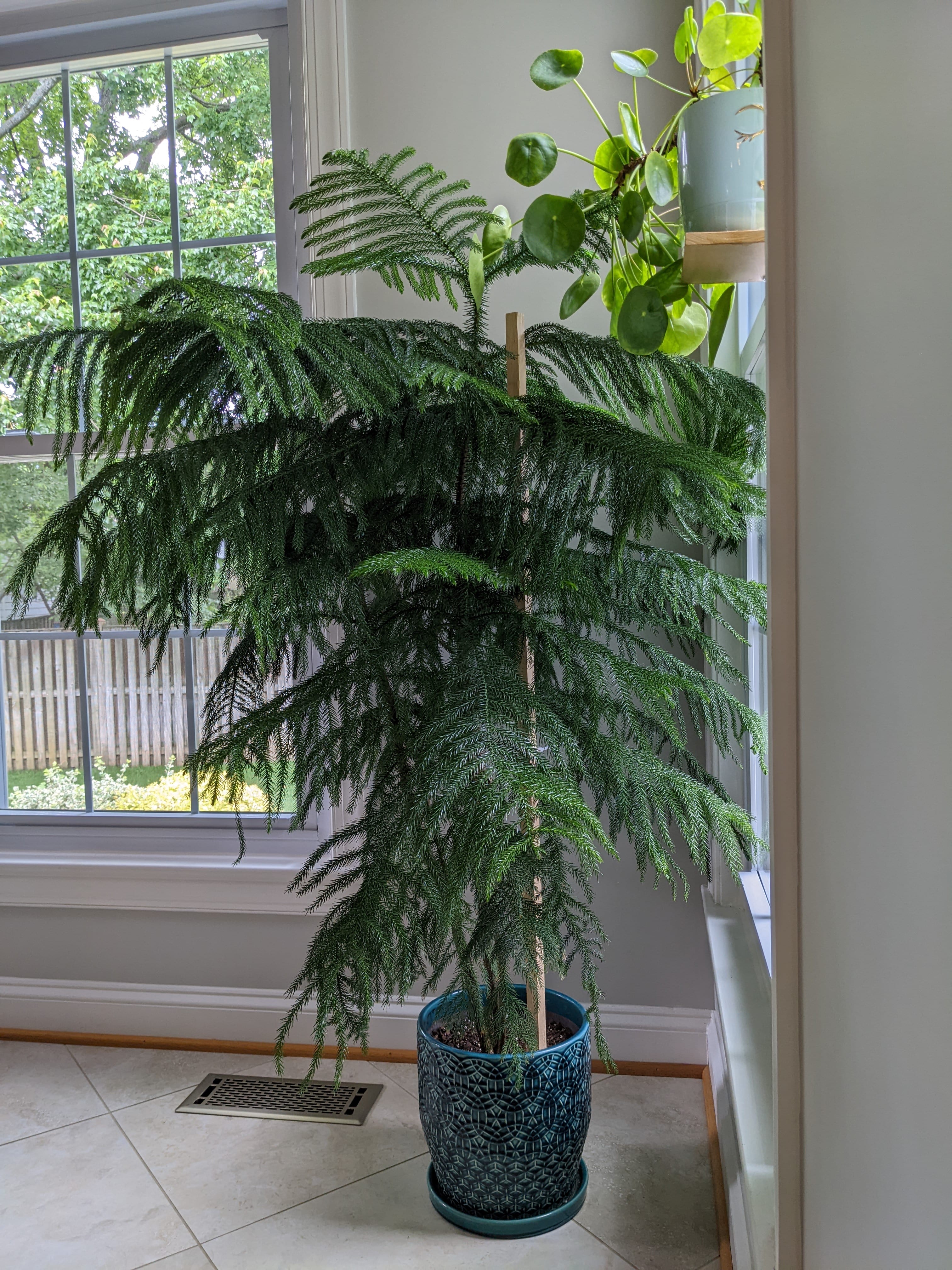Most of the Norfolk Island Pines that I have seen sold as houseplants typically have multiple trunks. Sometime the trunks appear to branch off from one another at the based and other seem like entirely separate plant trunks that are potted and sold in the same pot. I’m not sure why that is Norfolk Island Pine sellers’ general practice, but it seems to be the trend. Especially the ones that are available in the big box stores around Christmas. My theory is that a single Norfolk Island Pine plant in a pot doesn’t look as full or luscious.
Norfolk Island Pine Multiple Trunks

Should I Separate the Trunks
The first thing people want to know is should they separate their Norfolk Island Pine trunks? My personal recommendation is no. Norfolk Island Pines have very fine roots and the roots of the several plants that have been potted together will have really intermixed and intertwined. In my opinion, it is very tough to separate plants with these super-fine types of roots without doing significant damage to the roots of each of the trees. You’re risking losing all of the plants if you decide to divide them. In addition, I really like the fuller look of a pot with multiple trunks planted. Nonetheless, if you still want to separate your Norfolk Island Pine multiple trunks, then follow my guide on dividing plants. In that post, I divided Crotn plants, but the general guidelines are the same.
Care for a Multiple Trunks
Light Needs
For the most part, caring for a Norfolk Island Pine with multiple trunks is not much different than general Norfolk Island Pine care. They like bright to moderate direct light. I have kept mine in an east-facing window for many years and it seems to be pretty happy there. They can definitely handle stronger light from a south or west-facing window though too. One light consideration that I think matters even more when you have multiple trunks is to rotate your plant so that each side gets light equally. If you don’t, you will end up with one trunk growing much better that the others or leaning to one side. I like to do a quarter of a turn each week to ensure even light access to each side.
| Light Needs | Watering Needs | Soil Needs | Fertilizing Needs |
| Bright to moderate direct light. | Keep soil moist but not soggy. | Well draining potting soil. | Monthly during the growing season. |
Water Needs
The Norfolk Island Pine is actually a tropical plant and enjoys some moisture. In fact, I failed twice at growing a Norfolk Island Pine before I finally got the hang of it. The soil should stay moist but not wet. Early in my plant collecting days, I was so afraid of overwatering that I erred on the side of underwatering, which will not work for Norfolk Island Pines. Steer clear of terracotta and other pots that are known to dry up fast. I have found ceramic to work better for my Norfolk Island Pine. As always, your pot should still have drainage hole(s).
A pro-tip I’ve learned from having a multiple-trunk Norfolk Pine is that certain sides of the pot seem to dry out faster than others. You can use a soil moisture meter to test this. It’s usually the side with the thicker trunks. It’s always to a good idea to check multiple spots in the pot with your moisture meter because you don’t want to skip watering just because one side of the pot is still moist.
Norfolk Island Pines are so moisture-loving that they also do well with moist air from a humidifier. If you’re not ready to commit to that level of humidity you can also routinely spray it with a water.
Fertilizer Needs
Norfolk Island Pines do not need heavy fertilization. You definitely only want to fertilize during the the growing season. Any balanced water-soluable fertilizer should do. Be sure to follow the fertilizers instructions on dilution too and even if the instructions say to fertilize every two weeks or some higher frequency, I wouldn’t recommend more often than a month. Norfolk Island Pines are pretty slow growing and just do not require frequent fertilization, not even if it has multiple trunks.
Repotting
Norfolk Island Pines do not require frequent repottings. For one because they are slow growing as mentioned before. In addition, needlessly repotting a Norfolk Island Pine risks damaging their fragile root systems. Generally speaking, you can easily make it three to four years in between repotting. If you think you should repot your plant, take a peek at the roots to see if they are filling out the pot. If not, check again next year.

Does your Norfolk Island Pine have multiple trunks? Share your experiences and questions in the Coments section below.

I'm a long time plant lover on the quest to happily coexist with as many plants as I can. Let's grow!
